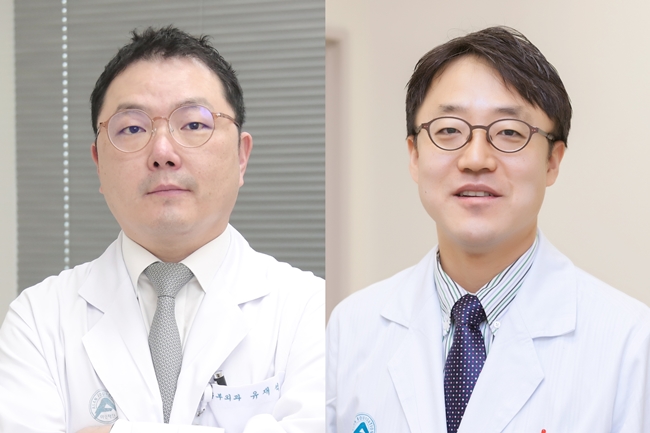-
- Global AMC MENU
- NEWS
- HEALTH
- PEOPLE
- Introduction
When Complications Occur, Removal of the Previously Implanted Artificial Valve is Complex and Requires Open-Chest Surgery, Leading Many Patients to Abandon Treatment
Professors Jae Suk Yoo and Duk-Woo Park’s Team at Asan Medical Center Successfully Performs Minimally Invasive Treatment on an Octogenarian Patient
“We Will Broaden the Application of 3D Full Endoscopy, Which Reduces Pain and Enables Faster Recovery, to Enhance Patients’ Quality of Life”

▲ (From left) Professor Jae Suk Yoo from the Department of Thoracic and Cardiovascular Surgery and Professor Duk-Woo Park from the Division of Cardiology at Asan Medical Center
The transcatheter aortic valve implantation (TAVI), a procedure that replaces a narrowed and calcified aortic valve with an artificial valve using a stent, is being actively performed for elderly patients with severe aortic stenosis.
However, in rare cases when complications occur, a redo TAVI may be required, involving the removal of the previously implanted valve and the insertion of a new one. Since removing the existing valve is highly complex, the procedure is regarded as highly challenging.
Recently, a team led by Professor Jae Suk Yoo from the Department of Thoracic and Cardiovascular Surgery and Professor Duk-Woo Park from the Division of Cardiology at Asan Medical Center successfully performed a redo TAVI using a fully 3D endoscopic approach. The procedure was carried out in a minimally invasive manner on an 85-year-old male patient who developed valve degeneration seven years after undergoing TAVI.
As the world’s first successful case of redo TAVI using a fully 3D endoscopic approach, the procedure has drawn significant attention from the medical community. The case was recently published in ‘JACC: Case Reports.’
In addition, Professor Jae Suk Yoo has been invited as a speaker at the Endoscopic Cardiac Surgeons Club and is scheduled to present in Cincinnati, United States, this September.
After more than a decade following TAVI, some patients may require retreatment due to the limited durability of the prosthetic valve or the recurrence of vascular narrowing. While redo TAVI can often provide a solution, complications such as valve degeneration, paravalvular leakage, or infection may necessitate redo TAVI.
Redo TAVI is considered a highly complex procedure because it requires both the removal of the previously implanted valve and the implantation of a new one. Since the implanted valve is often firmly attached to the surrounding tissue, the procedure has traditionally been performed through open-heart surgery. However, open-heart surgery involves a long recovery period, and many elderly or high-risk patients with comorbidities often decline surgery and instead manage their symptoms with medication alone.
A team led by Professors Jae Suk Yoo and Duk-Woo Park at Asan Medical Center recently became the first in the world to successfully perform a minimally invasive redo TAVI using a fully 3D endoscopic approach, simultaneously removing and implanting a prosthetic valve. The operation was completed in less than two hours, and the patient was discharged in good health just nine days later.
Compared with conventional minimally invasive cardiac surgery, which requires a 6 to 8 cm incision, fully 3D endoscopic cardiac surgery involves only a 3 to 4 cm incision. A 3D camera-equipped endoscope is inserted, and the operating surgeon, wearing special glasses, views the 3D images transmitted in real time while manipulating surgical instruments in place of direct hand movements. This approach allows the surgeon to visually perceive depth and thickness within the body and provides high-resolution imaging throughout the procedure.
Unlike traditional open-heart surgery, fully 3D endoscopic cardiac surgery requires only a very small incision, which significantly shortens recovery time. Because there is no bone cutting, patients experience less postoperative pain, and scarring is minimized, reducing both the physical and psychological burden. This makes the approach particularly suitable for elderly patients or those who may not tolerate open-heart surgery well. The success rate is comparable to that of conventional open-heart surgery.
Fully 3D endoscopic cardiac surgery was once limited to mitral valve repair, but its applications have recently expanded to include aortic valve replacement, cardiac tumor surgery, atrial septal defect repair, and atrial fibrillation surgery.
Professor Duk-Woo Park from the Division of Cardiology at Asan Medical Center stated, “In cases where retreatment is needed after TAVI, redo TAVI can sometimes be used to replace the prosthetic valve. However, for elderly or high-risk patients in whom repeat intervention is anatomically challenging, minimally invasive surgery using fully 3D endoscopy offers significant benefits.”
Professor Jae Suk Yoo from the Department of Thoracic and Cardiovascular Surgery at Asan Medical Center said, “Elderly and high-risk patients often gave up on surgery altogether due to the burden of open-heart surgery, but this procedure using fully 3D endoscopy is expected to serve as a valuable alternative. We plan to gradually expand its applications to provide patients with more treatment options and contribute to improving their quality of life.”












